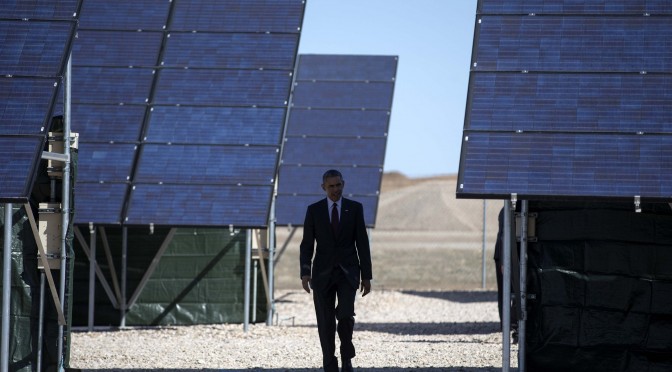President Obama at Hill Air Force Base in Utah, where he announced a new goal of training 75,000 workers for the solar energy industry by 2020.
President Obama launch a new initiative to expand the nation’s solar industry workforce during a visit to Utah’s Hill Air Force Base on Friday, seeking to gain support for his economic agenda in a heavily-Republican state.
The Energy Department will seek to train 75,000 people — including veterans — to enter the solar workforce by 2020, increasing the goal it set in May 2014 by 25,000.
“We’ve got to be relentless in our work to grow the economy and create good jobs,” Obama said after touring the brief tour, adding that other nations are seeking to expand their economies as well. “And that’s why we have to redouble our efforts to make sure that we’re competitive, to make sure that we’re taking the steps that are needed for us to be successful.”
Dan Utech, deputy special assistant to the president for energy and climate change, told reporters in a phone call Friday the initiative reflects the president’s conviction that “no challenge poses a greater threat to future generations than climate change.”
Utech noted the solar industry is adding jobs 10 times faster than the rest of the economy, and many of them are in construction and installation. Last year the solar industry the US installed 6,201 megawatts (MW) of solar photovoltaics and 767 MW of concentrating solar power, according to the Solar Energy Industries Association, enough to power the equivalent of about 1.4 million homes.
“We’ve made huge strides in recent years,” he said, noting that it had grown 20-fold between 2008 and 2014. “It’s also creating jobs, good-paying American jobs.”
President Obama launch a new initiative to expand the nation’s solar industry workforce during a visit to Utah’s Hill Air Force Base on Friday, seeking to gain support for his economic agenda in a heavily-Republican state.
The Energy Department will seek to train 75,000 people — including veterans — to enter the solar workforce by 2020, increasing the goal it set in May 2014 by 25,000.
“We’ve got to be relentless in our work to grow the economy and create good jobs,” Obama said after touring the brief tour, adding that other nations are seeking to expand their economies as well. “And that’s why we have to redouble our efforts to make sure that we’re competitive, to make sure that we’re taking the steps that are needed for us to be successful.”
Dan Utech, deputy special assistant to the president for energy and climate change, told reporters in a phone call Friday the initiative reflects the president’s conviction that “no challenge poses a greater threat to future generations than climate change.”
Utech noted the solar industry is adding jobs 10 times faster than the rest of the economy, and many of them are in construction and installation. Last year the solar industry the US installed 6,201 megawatts (MW) of solar photovoltaics and 767 MW of concentrating solar power, according to the Solar Energy Industries Association, enough to power the equivalent of about 1.4 million homes.
“We’ve made huge strides in recent years,” he said, noting that it had grown 20-fold between 2008 and 2014. “It’s also creating jobs, good-paying American jobs.”
The Energy Department will also join with the Pentagon to run the “Solar Ready Vets” program, which prepares veterans to work in the solar industry, at 10 military bases across the country. Those bases will include Hill Air Force Base, which has already installed solar panels onsite, as well as California’s Camp Pendleton, Colorado’s Fort Carson and Naval Station Norfolk in Virginia.
DOE Deputy Secretary Elizabeth Sherwood-Randall said during the call with reporters that the pilot program on Camp Pendleton had already produced results: Of the 20 Marines who completed training on Feb. 13, each received at least one job offer from the five major U.S. solar firms who are conducting recruiting as part of the program.
The transition from active military duty to the private sector “is a vulnerable moment for many of our veterans, and of course we want to support them in whatever way possible,” Sherwood-Randall said.
She added that the training program, which is free for military personnel, is an intensive, four to six-week session in which participants learn the skills needed to install solar panels and electrical systems, interpret building codes and serve as both sales representatives and solar system inspectors.
DOE has already spent $27 million on its nationwide solar instructor training network, which includes community colleges as well as military bases, but Sherwood-Randall said could not estimate the cost of expanding the program to seven additional military bases.



